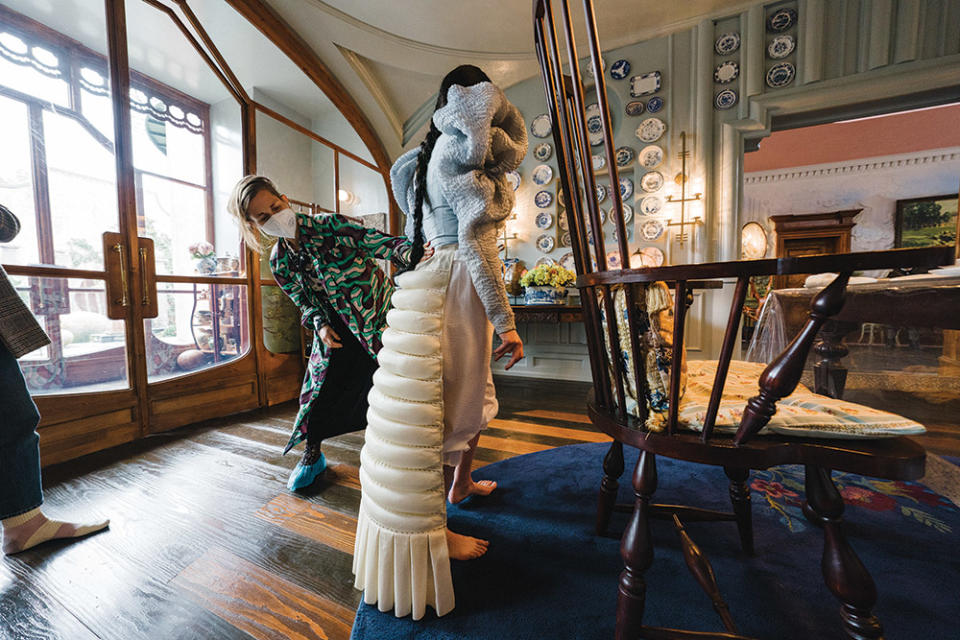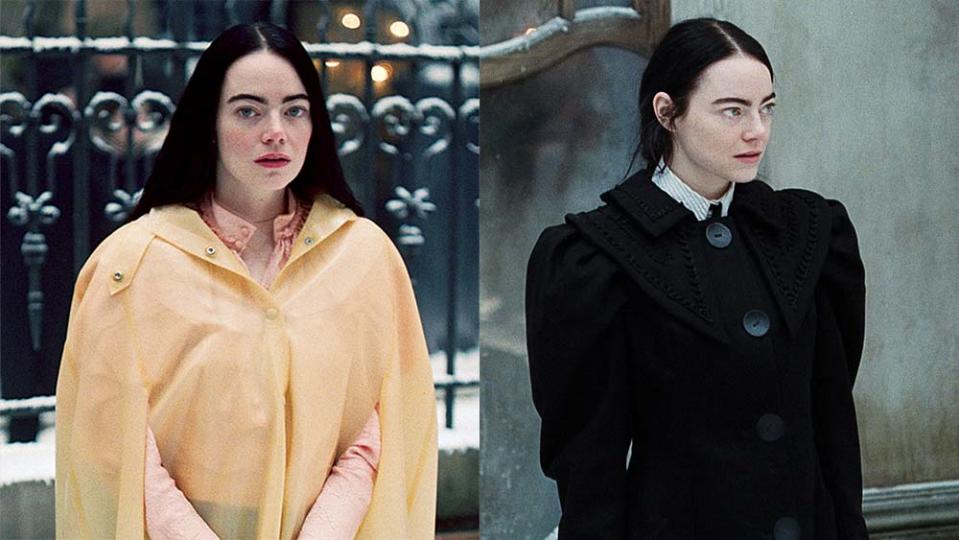Brothel Chic: The Sexualized Costume Design of ‘Poor Things’
- Oops!Something went wrong.Please try again later.
- Oops!Something went wrong.Please try again later.
- Oops!Something went wrong.Please try again later.

Well-versed in the modern period drama with a twist, director Yorgos Lanthimos (Dogtooth, The Favourite) had a simple edict for the costume design of Poor Things. As British costume designer Holly Waddington notes, “He didn’t want it to be like a period drama, he didn’t want it to be like a sci-fi film, and he didn’t want it to be too ‘fashiony.’ ” The result is Age of Innocence meets surrealism meets couture.
Adapted from Alasdair Gray’s novel, Searchlight’s Poor Things is a fantastical feminist fairy tale on steroids, where the character Bella Baxter (Emma Stone) is brought back to life with the brain of an inquisitive, no-holds-barred toddler by the Frankensteinish Dr. Godwin Baxter (Willem Dafoe). Set against a backdrop of London, Lisbon, Paris and Alexandria, the costumes support the narrative of a young woman’s social and sexual awakening.
More from The Hollywood Reporter

“Bella Style,” as Waddington calls it, comprises late-1800s Victorian with a contemporary bent and exaggerated silhouettes. While crop tops, ’30s-style underwear, flesh-colored blouses and an underpinning known as a bustle cage (which gave shape and volume to skirts) are just a few of the looks, the real standout — and one of the director’s favorites — is the big puffy sleeve.
This is no Seinfeld puffy shirt as made famous in the ’90s sitcom. As Waddington details, “There was a very brief window in the 1890s where women wore these huge sleeves, and once we started filming, the size of the sleeve blocked the camera angles. The big sleeves felt quite empowering and were like lungs full of breath and air that ignited and reanimated Bella.” The detailing of center pleats in the front bodice with lots of flaps, accompanied by a tightly fitted waist, soon became a joke between the designer and director, who named the costume staple the “vagina blouse.”
While costuming traditional period films is often a lesson in period-perfect authenticity, Waddington by contrast ranged freely in her work. “I was looking at very light fabrics that were beautiful and luxurious but not too grown-up,” she says. “To me, it was important there was a sense of organic in every detail. Victorian clothes are decorated with lots of beads, feathers and lace, which was a hallmark. I decided to forget that and go with my own dressing. Victorian dresses are heavily textured and involve a lot of bits of dead animals, such as feathers, so I found embossed silks and a beautifully woven mix of silks and linens to get these unruly textures.” Designing with an eye toward the present day also translated into the use of plastics, such as Bella’s yellow plastic mac.

The film’s beginning is captured in black-and-white, portraying Bella’s early years dressed in knickers, bloomers, ruffles, quilting and baby doll dresses. As she becomes older and discovers both her voice and sexuality, the film is shot in color, where she goes from flaps and frills to more formfitting structures such as a grande dame-style society costume for a grand tour and brothel chic for her stint working in a Parisian house of ill repute.
The color palette keys into the sexual overtones of the film. “I was exploring everything that had a connection to the body,” says Waddington. “I used a soft palette of pinks that look like human skin, and everything started to look like female genitalia.” The use of latex for a covering for Bella became another symbol (aptly named the “condom coat,” as it represents the color of a Victorian-era condom).
Beyond 1800s inspirations, the designer looked to a variety of references, such as Bella’s “tap pants” that were influenced by French knickers in the ’30s (and reminiscent of the Busby Berkeley costumes of the ’20s). The ’60s “space age” designers André Courrèges (white leather boots with peep toes) and Pierre Cardin, along with fashion icon Elsa Schiaparelli and cult favorite Moncler, were also influences.
Waddington saved the color black for Bella’s sojourn into socialist meetings and a career in medicine clad in a dark coat, bare legs and boots. “I used black once she entered the world of medicine,” she says. “I no longer wanted her to be conspicuous, as she was in medical school and wanted her to blend in, and the fabrics had to become more serious.”
Through Dec. 15, Waddington’s work is being celebrated at a special exhibit at ASU FIDM Museum in Downtown Los Angeles at 919 S. Grand Ave. Free and open to the public, the costume display features memorable looks from the film alongside Waddington’s original pencil sketches, props and behind-the-scenes photos from Lanthimos. The costume exhibit was unveiled Nov. 30 at an event hosted by costumer designer Arianne Phillips and attended by the likes of Jeremy Scott, costume designers Mark Bridges, Trish Summerville and Gunnar Deatherage, and actors Lola Glaudini, Harley Quinn Smith and Monet Mazur.

A version of this story first appeared in the Dec. 7 issue of The Hollywood Reporter magazine. Click here to subscribe.
Best of The Hollywood Reporter
Martin Scorsese’s 10 Best Movies Ranked, Including 'Killers of the Flower Moon'
13 Times Hollywood Predicted the Scary (or Not So Scary) Future of AI

